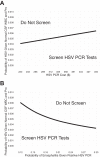Cost-Effectiveness Study of Criteria for Screening Cerebrospinal Fluid To Determine the Need for Herpes Simplex Virus PCR Testing
- PMID: 28298450
- PMCID: PMC5405275
- DOI: 10.1128/JCM.00119-17
Cost-Effectiveness Study of Criteria for Screening Cerebrospinal Fluid To Determine the Need for Herpes Simplex Virus PCR Testing
Abstract
The absence of markers of inflammation in the cerebrospinal fluid (CSF) commonly predicts the absence of herpes simplex virus (HSV) central nervous system (CNS) infection. Consequently, multiple authors have proposed and validated criteria for deferring HSV PCR testing of CSF in immunocompetent hosts with normal CSF white blood cell and protein levels (≤5 cells/mm3 and ≤50 mg/dl, respectively). Hosts are considered immunocompetent if they are ≥2 years old and have not had HIV or an organ transplant. Adoption of the criteria may erroneously exclude HSV-infected persons from a necessary diagnostic test or, alternatively, reduce the costs associated with HSV tests with minimal to no effect on patient care. Little is known about the cost-effectiveness of this approach. A decision analysis model was developed to evaluate the adoption of criteria for screening HSV tests of CSF. Estimates of input parameter values combined available literature with a multiyear multisite review at two of the largest health care systems in the United States. Adoption of criteria to screen for HSV test need proved cost-effective when less than 1 in 200 patients deferred from testing truly had an HSV CNS infection. Similar to prior studies, none of the deferred cases had HSV encephalitis (n = 3120). Adoption of these criteria in the United States would save an estimated $127 million ($95 million to $158 million [±25%]) annually. The model calculations remained robust to variation in test cost, prevalence of HSV infection, and random variation to study assumptions. The adoption of criteria to screen HSV PCR tests in CSF represents a cost-effective approach.
Keywords: cost-effectiveness; herpes simplex virus; polymerase chain reaction.
Copyright © 2017 American Society for Microbiology.
Figures




Comment in
-
Reply to Galen, "Screening Cerebrospinal Fluid Prior to Herpes Simplex Virus PCR Testing Might Miss Cases of Herpes Simplex Encephalitis".J Clin Microbiol. 2017 Oct;55(10):3144-3145. doi: 10.1128/JCM.01144-17. J Clin Microbiol. 2017. PMID: 28947510 Free PMC article. No abstract available.
References
Publication types
MeSH terms
Substances
LinkOut - more resources
Full Text Sources
Other Literature Sources
Medical

